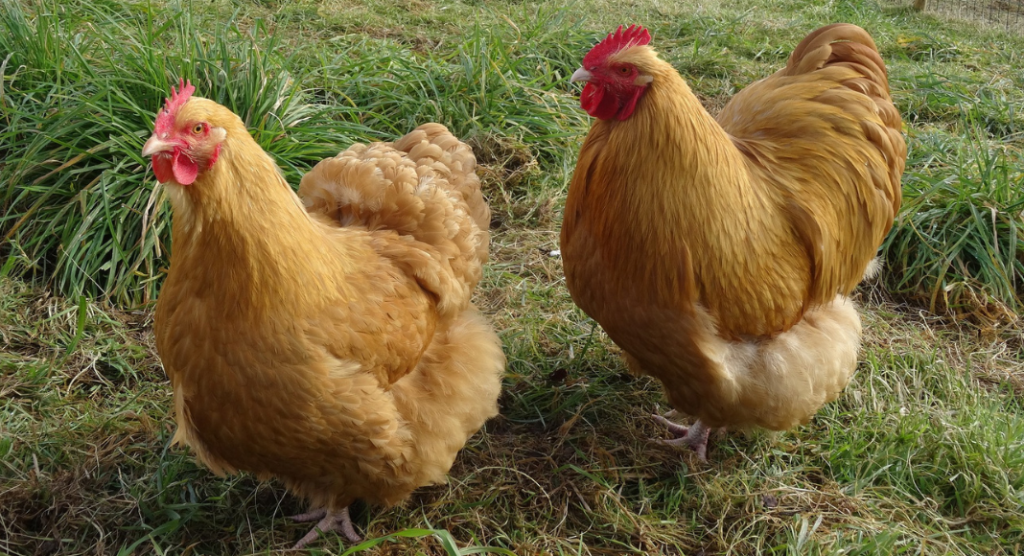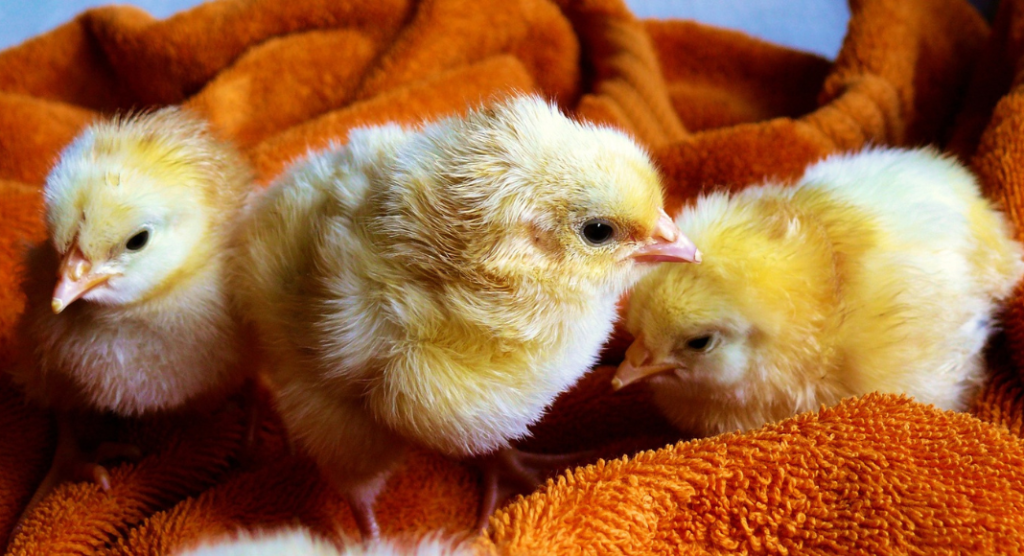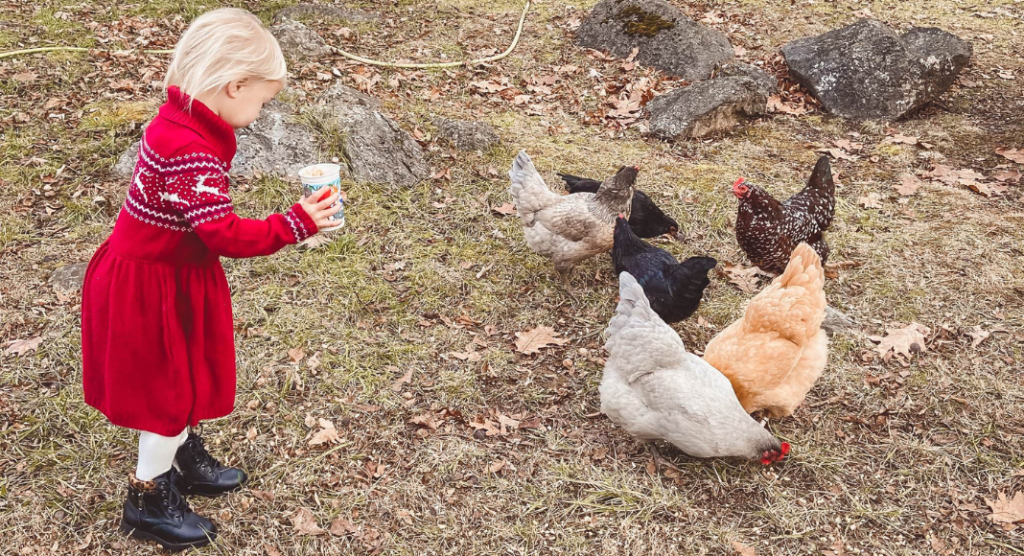 The recent skyrocketing egg prices and surge in popularity of glamorous-looking homestead social media accounts may have you contemplating venturing into chicken ownership. Chickens are a fun and rewarding pet/farm animal to keep, however if you’re thinking they’ll save you money on eggs, that may not necessarily be the case. And, as with all animals, keeping chickens isn’t always as glamorous as the Instagram pictures lead one to believe. The good news is that chickens are relatively easy to own.
The recent skyrocketing egg prices and surge in popularity of glamorous-looking homestead social media accounts may have you contemplating venturing into chicken ownership. Chickens are a fun and rewarding pet/farm animal to keep, however if you’re thinking they’ll save you money on eggs, that may not necessarily be the case. And, as with all animals, keeping chickens isn’t always as glamorous as the Instagram pictures lead one to believe. The good news is that chickens are relatively easy to own.
I’m going to share some things to consider and basics of chicken ownership should you decide to take the leap!
The first thing to clarify before you get chickens is if you are allowed to have chickens where you live. As a general rule of thumb, chickens are allowed in Knoxville City and Knox County, though roosters are not allowed in city limits and there may be quantity restrictions and other limitations depending on your specific zoning. You will also want to check your neighborhood’s HOA covenants and restrictions as many do not allow chickens.
If you’re in the clear to have chickens, it’s time to start planning out your flock! Chickens are a flock animal, so you’ll want at a minimum three chickens. If you’re limited on space or want to keep the flock small, three to four is a good number for companionship and some daily fresh eggs.
This brings up a common question: Do you need a rooster to get eggs? The answer is no! Chickens lay eggs whether fertilized or not. It’s most common among beginner chicken owners to have a flock of only hens. Some reasons to consider having a rooster would be protection for the hens or breeding chickens. However, roosters can be mean, have the dreaded cock-a-doodle-do, and are also not as commonly allowed as hens. So, unless you have the space and desire to go all-in on chickens and roosters, it’s probably best to start with hens only.
Also, be aware of chicken math as you plan out how large you want your flock to be. Hens stop laying after a few years, but can live for several years after that. Will you be keeping them and adding new layers or starting over with your flock? If you plan to add chickens to an established flock, you’ll need at least two or three added at a time for the buddy system. Chickens establish a flock hierarchy, a pecking order (now you know where that phrase came from), and any new additions may have a hard time fitting in without some companions going through it with them. Most places you acquire chickens from will have a minimum amount they’ll sell, making it easy to accumulate more chickens than originally planned, so it’s always good to build in a future contingency plan allowing for at least a few more additions.
There are many different breeds of chicken to choose from, which may surprise you. I suggest spending some time reading up on the different breeds to figure out what kinds you would be interested in. Of course, you can also just go with a barnyard mix (a chicken mutt). Some things to consider that vary by breed include looks, size, temperament (including broodiness!), cold/heat tolerance, egg production, and egg color. Our family’s personal favorite, kid-friendly chicken breed is the Buff Orpington, which is often considered the golden retriever of the chicken world. Another kid-friendly breed includes the Brahma, a gentle giant. Both of these breeds lay about 3-5 medium brown eggs a week. Silkies are another fun breed great for kids. They are a bantam chicken, which is a miniature chicken, and are tiny fluff balls. Cochins, Australorps, and Wyandottes are other great kid-friendly breeds to consider.
 You may also choose a breed specifically for egg production. If you’re going for a large quantity of eggs, a White Leghorn or Rhode Island Red, may be a good chicken to consider. If you want blue eggs, an Ameraucana, Cream Legbar, or Americana (Easter Egger) should be a part of your flock. There are also Olive Eggers, which lay olive green eggs. If you want dark brown eggs, you’ll want a Black Copper Maran.
You may also choose a breed specifically for egg production. If you’re going for a large quantity of eggs, a White Leghorn or Rhode Island Red, may be a good chicken to consider. If you want blue eggs, an Ameraucana, Cream Legbar, or Americana (Easter Egger) should be a part of your flock. There are also Olive Eggers, which lay olive green eggs. If you want dark brown eggs, you’ll want a Black Copper Maran.
A word about broodiness mentioned above. Broodiness is the chicken’s instinct to hatch eggs and become a mama hen. This is great if you are planning on breeding chickens with a rooster or increasing your flock size. However, it’s not a fun character trait when there’s no fertilization happening. Broody chickens will guard eggs in the nesting box for weeks and become a nuisance to you and the rest of the flock trying to access the nesting boxes. To solve this, you either need to slip your lady a baby chick to raise or follow various techniques to break her of her broodiness. This can become quite a hassle if you have a hen prone to going broody often.
So now that you have a general idea of the type and size of flock you want, you can start planning accommodation for them.
Chickens don’t need a lot of space, but you’ll want to plan for their space needs based on the lifestyle you plan for them, as that can change their space needs. There are really three different lifestyle options for chickens: coop only (or coop and tiny run), coop and run, or coop and yard (or coop, run, and yard). Technically, there could also be yard only chickens, but that is not as common. Think of the coop as the fully enclosed house the chicken stays in. The run is a fenced in area for the chicken to roam. Chickens can also free-range out in the yard if this setup will work on your property. Fun fact: chickens develop an attachment to their home base, so you don’t have to worry about them running off if they are free range. After you establish their coop as home, they will return to it at sundown even after a day of free roaming.
If your plan is mainly coop, you should aim for 8-10 square feet of space per bird. If you can offer them a generous sized run, you only need 4-5 square feet of space in the coop per bird. If they will have access to the yard during the day, then that number drops to about 3 square feet per bird.
The coop will likely be your biggest investment in getting started with chickens. There are many different coop options. Coops can either be stationary or movable (often called a chicken tractor and great for exposing your chickens to different sections of the yard without actually having them free-range in the yard). They can be bought from a box store and assembled or handmade. There are many different aesthetics and price points of coops. Your choice of coop is really up to you as long as you make sure it meets the size needs of your flock. And another important thing to focus on with your coop is safety for your birds. The coop should be like a miniature Fort Knox to keep potential predators at bay and be able to be shut up at night.
 Coops will need to be lined with bedding to provide comfort and warmth for the birds. There are also different considerations for the material on the ground of the run. Inside the coop, typical options include pine shavings, sand, or straw. I advise you to read up on the pros or cons of each to make your decision. If you go the sand route, your approach to cleaning the coop will resemble more of an upkeep of a cat’s litter box. If you go the shavings or straw route, you can either frequently/periodically change out the bedding or follow a deep litter method depending on your preferences. I prefer the deep litter method for its simplicity in upkeep. For your run, you may just keep the ground natural with grass (though this will likely die off over time if the run is stationary) or dirt or you could line the run with wood chips or sand.
Coops will need to be lined with bedding to provide comfort and warmth for the birds. There are also different considerations for the material on the ground of the run. Inside the coop, typical options include pine shavings, sand, or straw. I advise you to read up on the pros or cons of each to make your decision. If you go the sand route, your approach to cleaning the coop will resemble more of an upkeep of a cat’s litter box. If you go the shavings or straw route, you can either frequently/periodically change out the bedding or follow a deep litter method depending on your preferences. I prefer the deep litter method for its simplicity in upkeep. For your run, you may just keep the ground natural with grass (though this will likely die off over time if the run is stationary) or dirt or you could line the run with wood chips or sand.
A few other things you’ll want to furnish your coop with include a roosting bar (because chickens are birds and sleep on perches), a feeder, a waterer, and enough nesting boxes (one per every four chickens). If your chickens do not have access to dirt (if you line your run with wood chips), you’ll want to offer a place to dirt bathe. You may also want to add some toys such as a swing and scratch and peck food dispenser.
Once you have acquired a coop, you can look into getting some birds. There are a couple of different routes you can go with to get your dream flock. First you have to decide if you are going to start with chicks, pullets, or laying hens. Technically, you could also start with hatching eggs, but that would require an incubator, which may be a big first step if you’re just starting out as a chicken owner.
A chick is a chicken that is less than 6 weeks of age. It is going to require some special care in those first 6 weeks of life that you may or may not want to undertake. You will need to keep them in a brooder box separate from any older birds and provide them with adequate heat until they grow their adult feathers. Besides the special care, another downside to getting chicks is that most breeds of chickens you cannot tell if it’s a hen or a rooster until several months of age by either it laying eggs or cock-a-doodle-dooing (you can start to guess based on appearance of combs, wattles, tails, and neck feathers at a few months of age, but some chickens again are hard to distinguish in this area). There are a few select breeds that can be distinguished and ordering from a hatchery that guarantees the bird’s sex can combat that, but for the most part, chicks are acquired in what is known as “straight run” fashion, which means you’ll find out later if you’ve got a rooster or hen, which may lead to some flock rearranging down the line. The upsides though of getting chicks are that they are cheaper and you have more bonding time with the birds. We are raising from chicks this spring for that extra bonding time and educational experience for the kids. Chicks are also pretty easy to acquire, especially in the springtime. You are probably familiar with the giant bins of chicks at the local farm stores. You can also order day old chicks from large hatcheries that will deliver to you in the mail! This is a great route for acquiring particular breeds. Several reputable and popular hatcheries that are fairly close to us include Meyer Hatchery, Murray McMurray Hatchery, and Mr. Healthy Hatchery.
 The other option is to acquire pullets or laying hens. Pullets are female chickens less than a year of age but that have made it past the chick stage. These are the prime birds to acquire because they are about to or already laying eggs for you to enjoy. Chickens usually start laying eggs between four and eight months of age depending on the breed and time of year. There are no special care requirements for pullets (though you’ll want to be careful still in slowy introducing into an existing flock). That does mean that you will be paying a premium for these birds. You can also buy already laying hens. If already laying, but over a year, the price point typically falls off a bit from pullet because you are going to have a truncated amount of time with them laying for you. Pullets and laying hens are a little harder to come by than chicks as you aren’t typically going to find them at the store, but there are still lots of options for acquiring them including Craigslist and local farmer exchanges. There are also several great local chicken groups on Facebook that can not only connect you to knowledgeable people who can share a wealth of insight into bird ownership, but also connect you to people whom you can purchase birds from.
The other option is to acquire pullets or laying hens. Pullets are female chickens less than a year of age but that have made it past the chick stage. These are the prime birds to acquire because they are about to or already laying eggs for you to enjoy. Chickens usually start laying eggs between four and eight months of age depending on the breed and time of year. There are no special care requirements for pullets (though you’ll want to be careful still in slowy introducing into an existing flock). That does mean that you will be paying a premium for these birds. You can also buy already laying hens. If already laying, but over a year, the price point typically falls off a bit from pullet because you are going to have a truncated amount of time with them laying for you. Pullets and laying hens are a little harder to come by than chicks as you aren’t typically going to find them at the store, but there are still lots of options for acquiring them including Craigslist and local farmer exchanges. There are also several great local chicken groups on Facebook that can not only connect you to knowledgeable people who can share a wealth of insight into bird ownership, but also connect you to people whom you can purchase birds from.
Now that you have your chickens, it’s time to care for them!
As I mentioned from the beginning, chickens are fairly easy to care for. Your daily chores (or some cases every few days depending on size of feeders/waterers) will be to provide them with fresh water and feed and collect any eggs. You’ll also want to open and shut the door to the coop in the morning and evening if you are giving them access to a run or yard. There are also automatic doors that can be set on timers to do this step for you.
For feeding your chickens there are different types of feed to consider. If you have chicks, there’s a special type of feed called chick starter with a higher protein content to help them grow. Once your chickens are laying age you will want to give them a laying feed, which has a higher calcium content.
You may also want to incorporate different treats/electives into their diet. There’s grit (which is basically very small rocklike material) which helps them internally grind up/digest their food (since they don’t have teeth), which you’ll want to include if they don’t have access to the yard. There’s also oyster shells, which are often given as another calcium boost (because chickens need a lot of calcium to produce eggs). You can also dry out, grind up, and feed back to chickens their own eggshells as another course of calcium. Chickens also enjoy treats such as mealworms and cracked corn. These are especially good to give if your chickens do not have access to the yard where they can find their own insects and treats.
 If your chickens do have access to the yard, even better. They will find their own nutrient dense food and you’ll likely notice from even darker yolk colors. They are also great at eliminating pests in the yard such as ticks. And because they are eating out in the yard all day, they will consume less feed than their counterparts who stay in the coop or run.
If your chickens do have access to the yard, even better. They will find their own nutrient dense food and you’ll likely notice from even darker yolk colors. They are also great at eliminating pests in the yard such as ticks. And because they are eating out in the yard all day, they will consume less feed than their counterparts who stay in the coop or run.
Chickens can also be fed kitchen scraps, which is an awesome way to reduce waste and cut down on feed costs! In fact, chickens are a wonderful way to combat food waste! You can feed your food waste to chickens and then they will return the favor in egg production. As an aside, if you are also up for venturing into composting, chicken waste mixed with soiled bedding is a great addition to your compost giving back in multiple ways! Chickens will eat most kitchen scraps including fruits, vegetables, meat, and dairy. There’s just a few things to avoid for sure with chickens such as moldy food, dried beans or rice, avocados and fruit pits, chocolate, coffee, green/raw potatoes, leaves and unripe fruit from the nightshade family, and large quantities of citrus.
Depending on the type of bedding you choose, you will have to keep up with the cleanliness of the coop in various ways such as changing out bedding or wiping down roosting bars. A clean coop keeps disease at bay. Some owners choose to line their coops with certain herbs or products to deter disease and unwanted creatures. As a chicken owner it’s also a good idea to familiarize yourself with common potential chicken ailments such as mites, sour croup, egg bound, and respiratory infections, and what to do to prevent or treat them.
 This may seem like a lot to digest, but once you get up and going with chickens, they are really pretty low maintenance animals to keep. They are a fantastic “pet” as you can develop wonderful bonds with them, and you also get to enjoy the benefits of fresh eggs.
This may seem like a lot to digest, but once you get up and going with chickens, they are really pretty low maintenance animals to keep. They are a fantastic “pet” as you can develop wonderful bonds with them, and you also get to enjoy the benefits of fresh eggs.



















